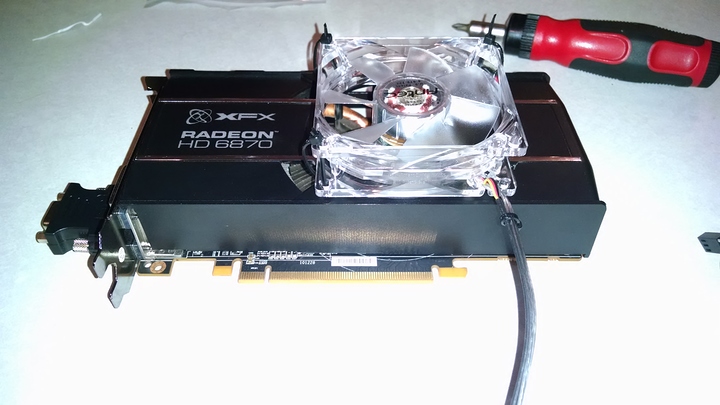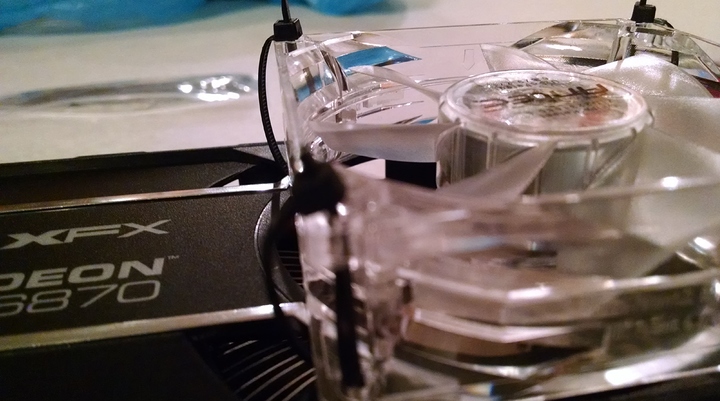I have a pair of pictures showing the result of about $40 worth of materials that went into reviving an HD 6870. The reason I blew the cash on this and why this particular card is a funny story that I posted down below.
If you want to know the cooling results, it stays at 50 degrees Celcius at idle, and between 65-80 degrees Celcius playing PayDay 2 at max settings at 1440 x 900 for about an hour. I have the core overclocked to 910MHz, 10MHz more than stock. It's unstable past that. Weird, huh? (Sorry I said 950MHz before, must not have been looking)
Here's the pictures! Tell me what you think, and feel free to ask me anything I don't mention down below!
So, for the curious...
The GPU itself was given to me by my brother. His place of work was throwing this card away, due to the card's fan failing. He managed to grab it and take it to me. I didn't have a GPU for my PC, so I was eager to put it in my system. Unfortunately, I found out the fan failed first hand. I took it out when it throttled at 100 degrees Celsius. Eventually, I gathered the cash to get this thing working instead of buying a GPU of equal performance for three times what it cost to do this.
This began with a trip to Best Buy (TigerDirect closed by then, and I had no patience to order anything off Newegg or Amazon and ship it back if it was defective or damaged) and a short walk to a little section in the store's corner. This section had nothing but generic crap. However, there was a small section of graphics cards, and beside them some 80mm fans and thermal paste. Nice! They had a brand name in stock I know most trust. Antec. I decided on the parts and went to buy them.
I left the place with their only real options for me. An 80mm Blue LED fan. It's pretty standard... and not. For example: It has and requires me to use BOTH a molex and 3-pin fan headed. One for the LED's, and one for the fan. It has a fan speed controller right on the 3-pin cable, going from 1,600, 2,000 and 2,500 RPM. It's loud, but pretty drowned out when gaming or at it's lowest speed. I'd rather just leave it at max for cooling reasons. The thermal paste, also by Antec, was straightforward. It was a little tube that had a cap, and syringe-like thing in the back for pushing out the paste.
I started by tearing the GPU apart, cleaning off the old paste and applying my own. Then I reassembled the card after making sure it was applied correctly. I unpack the fan and take out the cable ties I already had. I remove the stock fan seeing as its existence between the new fan and the heatsink will get in the way of heat dissipation. I throw that out. I then begin the tedious and frustrating process of getting the fan attached to the plastic shroud via the slits in the thing. I had misjudged the distance between these slits as I thought an 80mm fan would fit. Just barely. I had to fight against the leverage and rigidness of the shroud, as well as get at an angle to when I could grab the cable tie after pushing through the fan hole and slits in the shroud.
After about 20 minutes I settled on 3 of the 4 corners and tightened everything. The cable ties, the fan power cables, the screws, and eagerly brought it to my personal rig. I had to hook up that damn fan to my PSU and motherboard directly, and use an adapter to attach one of the two 6-pin PCI connectors to the graphics card itself. I used the rest of the cable ties to zip it out of the way of the fan and the other parts of my system. It was finished.
After playing games and checking back and forth between GPU-Z, I have to say: I'm really impressed with what I could get away with for what I had gone through. It's amazing to me, not only because it worked, but because it save me about $120 since I was planning on getting a GTX 750 Ti. I'm happy, it looks decent, and it does what I wanted to. That's all I care about, and can't wait to see what you guys think! Thanks for reading!

